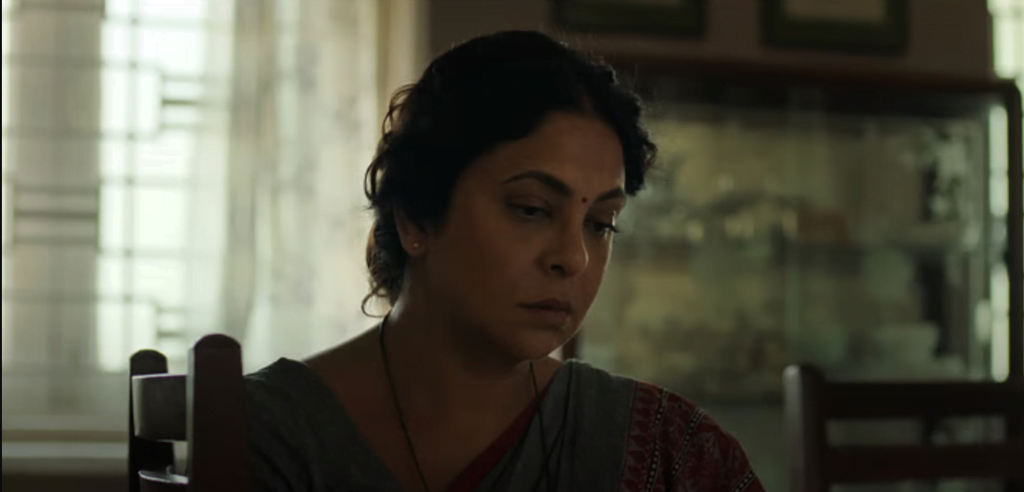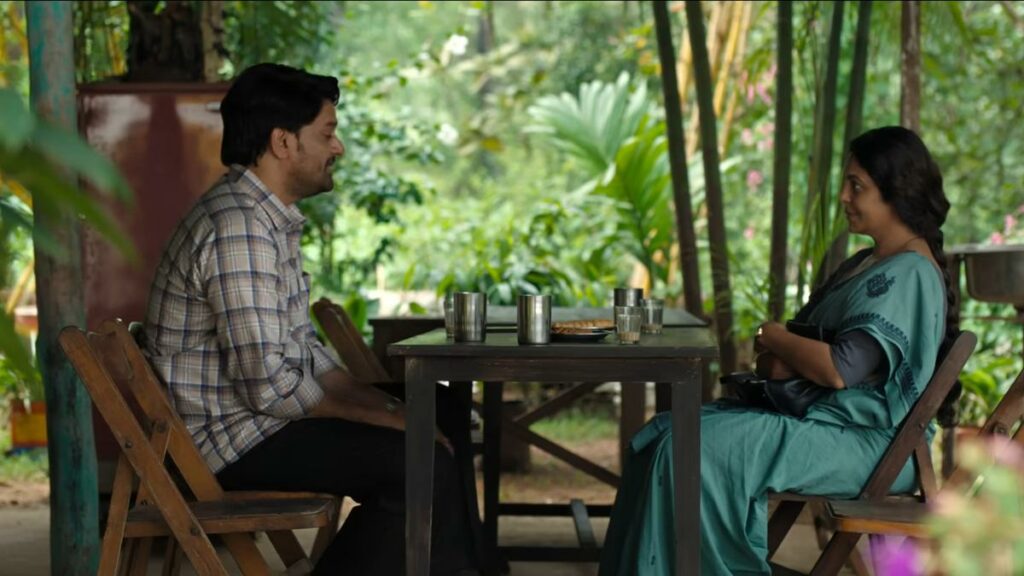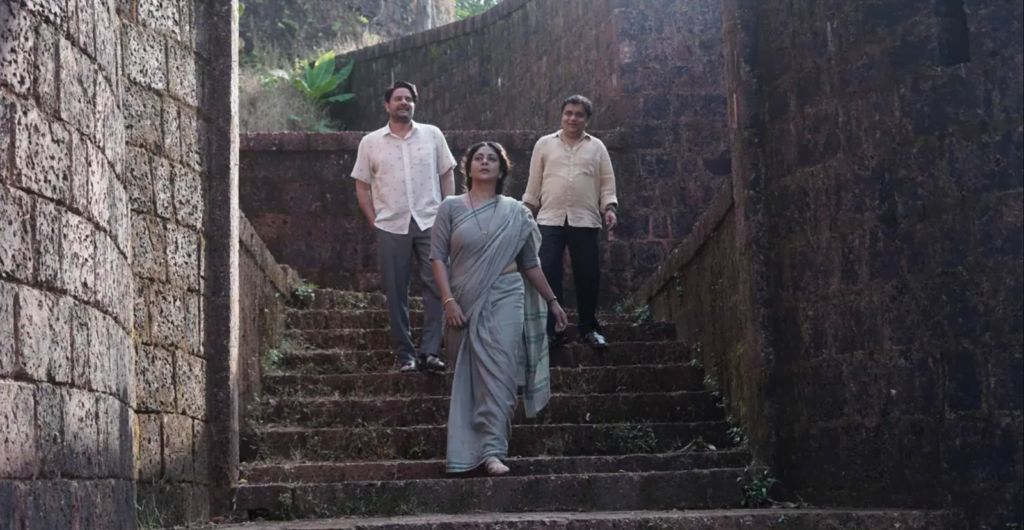Lost love, memory erasure and trauma form a triangle of concepts in the 2023 film Three of Us by Avinash Arun, who has made his mark through his 2014 film Killa which was acclaimed critically. The titular characters of the film include Shailaja, played by Shefali Shah, her husband Dipankar, played by Swanand Kirkire, and her childhood love, Pradeep, by Jaideep Ahlawat.
The story revolves around Shailaja, who is diagnosed with dementia as she ensues on a trip to the village of Vengurla, where she has spent some years of her childhood. As she embarks on this journey with her husband Dipankar, she comes across the friends she had left behind, especially her childhood love, Pradeep, who still lives in Vengurla.
As the three of them relive through Shailaja and Pradeep’s childhood memories and trauma, a tale of memories unfolds. However, unlike other films where the concept of memory, past, and nostalgia is explored, Three of Us does not provide life-altering lessons or the improvement of the character arc. The film is driven mainly by the conversation between the three characters, which provides snippets of their lives 28 years ago.
As Shailaja drifts away from her memory, the necessity she feels to visit Vengurla is largely empathised by the audience – the need to go back to the roots, however painful it could be, is often a dominant emotion.
Memory, life and ‘Three Of Us’
Memory as a concept has always been discussed in films. The way it is embedded with nostalgia and trauma in Three of Us provides a novel take without overpowering the intricacies of memory and the past. The setting of the film and the locations have helped evoke the past in a very organic way – the shift from Mumbai to Vengurla has affected the mood, pace, and language of the film. The cinematography and the framing have elevated the storytelling in a very profound way.

Shailaja always felt alienated in the city of Mumbai, this increased when she was diagnosed with dementia. When she collects the leaves from Vengurla, it says that all leaves in Mumbai are of the same colour. It symbolises the exciting and colourful life in Vengurla and the monotony in Mumbai. When the woman who has been selling papad to her for years approaches her, she cannot remember her. Walking through the roads or watching people, she feels like a stranger.
But when she reaches Vengurla, she remembers her friend whom she last seen 28 years ago. She remembers the rooms of her previous house, she is even able to recognise her class when her friends are not. She remembers her dance class and the steps. Shailaja is not strange to Vengurla, even though it is not the same.
The portrayal of marital relationships
The film has also walked away from the binary of portraying relationships – it does not villainise or romanticise marital relationships. While Pradeep and Sarika share a very intimate relationship as a husband and wife, Sarika also calls him out for not helping her in the kitchen. While Dipankar emotionally supports his wife, he also asks her to put salt in the poha.

The portrayal of the relationships in Three of Us is raw and mature; it does not try to conceal the vulnerability and insecurity nor glorify the bare minimum. While the male characters can be effectively placed in the ‘men written by women,’ category, the effort put into discussing their emotional depth should be appreciated.
Love outside marriage
While the portrayal of extra-marital relationships is often treated with a sense of dysphoria, whatever degree the relationship might be, ‘Three Of Us’ walks away from this. Even though the film portrays the characters’ insecurity, especially that of Dipankar’s, it draws clear boundaries. While Dipankar has his moments of insecurity with Shailaja and Pradeep, it is never out of jealousy – when he asks Shailaja, ‘Were you ever this happy with me?‘ the viewers empathise with his sadness. He feels his love was never enough because he does not remember their happy moments. While Shailaja replies by saying, ‘When were we last sad together?‘ it implies the critical question in love – is it enough to share happy moments? This is where Dipankar becomes a profound character.

It is the same with Pradeep, her childhood love. It has been 28 years since they last saw each other; however, their bond and the conversation sound natural. Even though Shailaja had her family and friends in Mumbai, she longed to see Pradeep – not because of their romantic relationship but because of their beautiful bond. When their old teacher calls them Mogambo and Daga, it entails a thread of long-lost companionship. This companionship is understood and even appreciated by both Pradeep’s wife, Sarika, and Dipankar.
While Pradeep becomes her comfort and solace in Vengurla, it is with Dipankar with whom she shares her sorrows. While films portraying relationships try too hard and bring a no-stain picture, it is important to discuss insecurity and vulnerability. Dipankar is insecure and vulnerable; he constantly questions their love and life but simultaneously thanks Pradeep for taking his time out for Shailaja.
Avinash Arun’s symbolism in various scenes, especially that of children, signifies Shailaja’s yearning to confront her past but to grow away from it. As the children often appear in various frames, the viewers are reminded of Shailaja’s journey to Vengurla and her confrontation with the past. From their train journey to the last scene in the Mela, children play as symbols of something the characters have left behind and are eager to take back.

The performance by the actors, especially Shefali Shah, is commendable – the alienation she faces in Mumbai, the yearning in her eyes as she watches Bharatha Natyam in Vengurla, and the strangeness while she visits her former house – all prove a testament to her brilliance. Jaideep Ahlawat and Sawanand Kirkire do not fall any less, making the film an acting masterclass. As the film is set in a Konkan village that embodies warmth, it would have been better if the movie was taken in Marathi, giving it a more authentic ambience.
Three of Us shows how the projection of complexity in relationships, especially in marital relationships, is often inward and regressive. The effort the makers have put to explore the multiple emotions that unfold between the three characters instead of presenting a blanketed picture of monotony is visible, calling for more tellings on the same line.
About the author(s)
Hajara Najeeb is interested in topics concerning gender and minority rights. She also writes on cinema and its political implications. She has graduated from Tata Institute of Social Sciences.






